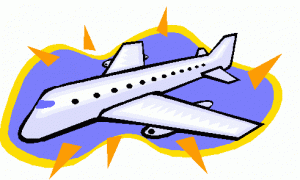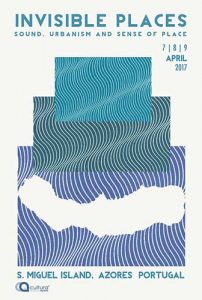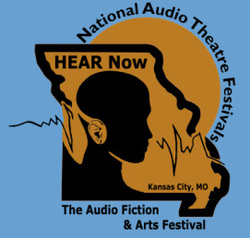
There some interesting conferences this spring for people interested in exploring some of the lesser known aspects of sound. In this post I will describe three of them. I expect to attend at least two of them, maybe all three. I am presenting a paper at Invisible Places. Full disclosure also requires me to say that I was on the board of NATF for several years and President of ICAD for four years. So I know these organizations and conferences and feel they are all worthwhile.
 INVISIBLE PLACES: Sound, Urbanism and Sense of Place
INVISIBLE PLACES: Sound, Urbanism and Sense of Place
www.invisibleplaces.org
April 7-9, 2017
Sao Miguel Island (Portuguese Azores)
Portugal
INFORMATION FROM THEIR WEBSITE
Many studies engaged with acoustic ecology have focused on urban environments, motivated by increasing concerns about the sensory impoverishment related to the dominance of anthropogenic sound associated with traffic and other types of transport, machinery from industry or construction, alarm signals and other sounding activities, which often mask and interfere with our living environment. These anthropogenic sounds have tended to be linked to a lack of environmental quality, as they inhibit the perception of other natural sounds. The sounds of the wind, the water, the voicing of certain animals originating from natural landscapes often contrast with human sounds in urban landscapes. They often share the same physical characteristics as measured by volume, duration, frequency or tone, but are experienced by humans differently. Beauty is in the ear of the beholder, we could say.
Soundscapes are part of any ecosystem and a fundamental manifestation of life. Every individual and species contributes and responds differently to a given sonic context with its own perceptual mechanism and will use diverse communication strategies. Development processes and urbanization have directly influenced the environment, often in negative ways that eliminate or diminish unique sounds, causing loss of social identity and cultural diversity.
Processes that occur in a landscape create patterns of sounds that can be identified. In turn, the entire phenomenon that inhibits or prevents effective acoustic communication can have consequences for the survival of individuals, species and ultimately, entire ecosystems. As our natural soundscapes morph and shrink, threats of extinction increase.
The future of cities is often related to the idea of city as a living environment dependent on and enriched by technology. A city should be seen as a sustainable community, where living organisms coexist and interact with man-made technologies integrated in our everyday life. Landscape therefore reflects the way humans interact with their natural world while organizing space and time. In this sense, landscape ecology should be expanded conceptually and imaginatively to encompass all the possible dimensions of human relations with and within the environment, including its living components.
The aim of this conference is to bring together scholars, artists and theoreticians on soundscape art and ecology and encourage them to present new perspectives that will further interdisciplinary research and practice. We still know little about the complex relationships between landscapes and soundscapes or the significance of acoustic ecology for all living organisms including ourselves. Focused study and intentional stewardship of our sound heritage for the holistic evaluation of landscapes is fundamental to the evolution of all species, and will have a great impact on the survival of many. This will be a central topic to be discussed.
Many scholars, researchers and sound artists (especially those whose work relates to soundscapes) will present papers, including your Audio Penguin, and there will be major keynote presenters:
Hildegard Westerkamp, a composer, radio artist and sound ecologist. She presents soundscape workshops and lectures internationally, performs and writes.
Sam Auinger is a sonic thinker, composer and sound-artist, who collaborates with city planers and architects regularly. He works together with the composer Bruce Odland as O+A, exploring the central theme of hearing perspective. Auinger has received numerous prizes and awards for his work.
Juhani Pallasmaa was professor of architecture at Helsinki University of Technology, director of the Museum of Finnish Architecture, visiting professor at various architecture schools around the world, and author of numerous articles on cultural philosophy, environmental psychology and theory of architecture and art.
In addition to the paper presentations and keynote talks, there will be other activities, including soundwalks, related to an awareness of sound and place.
The complete program, including a summary of all the papers, is available at the conference website (see above).
 HEAR Now: The Audio Fiction and Arts Festival
HEAR Now: The Audio Fiction and Arts Festival
presented by the National Audio Theatre Festivals (NATF)
www/hearnowfestival.org
June 8-11 2017
Kansas City, Missouri, USA
INFORMATION FROM THEIR WEBSITE
From ancient times until today, people have loved nothing more than to listen to a well-told story, a tall tale, a good yarn. Indeed, the spirit of the bards of old is still thriving.
To celebrate this spirit, the National Audio Theatre Festivals proudly presents HEAR Now!
HEAR Now is the audio equivalent of a film festival for fans, performers and producers of contemporary audio story-telling in all its forms: live and scripted solo performances, multi-voiced performance, classic radio drama, experimental narrative, and much more.
This four-day Festival offers a multi-faceted program showcasing the many forms of audio fiction and sound art story-telling in theaters and other “listening” venues. HEAR Now presents audio fiction programs that exemplify traditions of craftsmanship, as well as aesthetic and technological innovation.
The 2017 HEAR Now Festival will again be a gathering place where the work of master storytellers is celebrated and shared.
Audio drama, audiobooks, recorded, and live story-telling — sketches, poetry, spoken word — alongside academic papers, juried competitions, and presentations on the physics of sound, as well as performance workshops, will round out this intensive listening event for the 2017 Hear Now Festival.
To see more details, visit their website (see above)

ICAD 2017 – SOUND IN LEARNING
The 23rd International Conference on Auditory Display (ICAD)
icad.org/icad2017/
June 20-23, 2017
The Pennsylvania State University
Happy Valley Pennsylvania (central Pennsylvania)
USA
INFORMATION FROM THEIR WEBSITE
The Pennsylvania State University
Arts & Design Research Incubator, College of Arts & Architecture
Graduate Program in Acoustics, College of Engineering
College of Information Sciences and Technology
First held in 1992, ICAD is a highly interdisciplinary conference with relevance to researchers, practitioners, artists, and graduate students working with sound to convey and explore information. The conference is unique in its specific focus on auditory displays and the range of interdisciplinary issues related to their use. Like its predecessors, ICAD17 will be a single-track conference, open to all, with no membership or affiliation requirements.
ICAD 2017 is being hosted by the Arts & Design Research Incubator, the Graduate Program in Acoustics, and the College of Information Sciences and Technology.
The Arts & Design Research Incubator program within the College of Arts and Architecture is dedicated to supporting projects that are collaborative and interdisciplinary, push methodological boundaries, link research and teaching, or make innovative use of technology. Sonification has been a research emphasis within the incubator since its inception in 2014, and the College is pleased to strengthen this priority further by hosting ICAD 2017.
The Graduate Program in Acoustics at Penn State is a unique interdisciplinary program that leads to the degrees Master of Science in Acoustics, Master of Engineering in Acoustics, and Doctor of Philosophy in Acoustics. It is centered on acoustics, which is a subject that touches many diverse disciplines and allows many options for professional careers. While in the program, students can acquire and further strengthen their understanding and use of the fundamentals of engineering, physics and mathematics. The program offers the student a broad educational background applicable to many related scientific and technological fields giving the student lifelong flexibility for continued professional growth.
At IST, the focus is on creating intelligence. The digital age has made the world smaller, faster, more interactive and increasingly mobile. But no matter how fast and smart machines become, they still rely on the power of human creativity. It’s people that create new ways to look at and evaluate the infinite opportunities of the digital age. IST draws on a variety of knowledge disciplines to help individuals unlock the power of their own creativity and fuel the world’s most powerful problem solving machine—the human mind.
Your Audio Penguin will be at Invisible Places and ICAD for sure, and, money and time permitting, may be at all three. I invite discussion and questions from those interested in these specialty areas. For those unfamiliar with sonification, I would point you to the post “Listen to the Data” here on TheAudioPenguin.com. An introduction to soundscapes is part of “Audio Docs.” Please let me know if you plan to attend any of these events and I will try to meet up with you there.
thanks for the info, eric, give me a call.